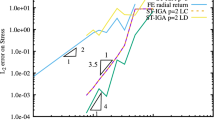Abstract
The stress-concentration problem for an elastic transversely isotropic medium containing an arbitrarily oriented spheroidal inclusion (inhomogeneity) is solved. The stress state in the elastic space is represented as the superposition of the principal state and the perturbed state due to the inhomogeneity. The problem is solved using the equivalent-inclusion method, the triple Fourier transform in space variables, and the Fourier-transformed Green function for an infinite anisotropic medium. Double integrals over a finite domain are evaluated using the Gaussian quadrature formulas. In special cases, the results are compared with those obtained by other authors. The influence of the geometry and orientation of the inclusion and the elastic properties of the medium and inclusion on the stress concentration is studied
Similar content being viewed by others
REFERENCES
M. Abramowitz and I. Stegun, Handbook of Mathematical Functions, Dover, New York (1970).
A. Ya. Aleksandrov and V. S. Vol’pert, “Some stress-concentration problems for an ellipsoidal cavity in a transversely isotropic body,” Izv. AN SSSR, Mekh. Tverd. Tela, No. 1, 115’121 (1970).
A. Ya. Aleksandrov and Yu. I. Solov’ev, Three-Dimensional Problems in the Theory of Elasticity [in Russian], Nauka, Moscow (1978).
V. T. Golovchan, “Solution of triply periodic problems in the statics of an elastic body with spherical inclusions,” Int. Appl. Mech., 22, No.7, 623’631 (1986).
A. K. Malmeister, V. P. Tamusz, and G. A. Teters, Resistance of Rigid Polymeric Materials [in Russian], Zinatne, Riga (1972).
Yu. N. Nemish, “Development of analytical methods in three-dimensional problems of the statics of anisotropic bodies (review),” Int. Appl. Mech., 36, No.2, 135’173 (2000).
A. G. Nikolaev and V. S. Protsenko, “The first and second axisymmetric problems in the theory of elasticity for doubly connected domains bounded by spherical and spheroidal surfaces,” Prikl. Mat. Mekh., 24, No.1, 65’74 (1990).
Yu. N. Podil’chuk, Boundary-Value Static Problems for Elastic Bodies, Vol. 1 of the six-volume series Three-Dimensional Problems of the Theory of Elasticity and Plasticity [in Russian], Naukova Dumka, Kiev (1984).
Yu. N. Podil’chuk, “Exact analytical solutions of three-dimensional boundary-value static problems for canonical transversely isotropic body (review),” Prikl. Mekh., 33, No.10, 3’30 (1997).
G. Ya. Popov, Elastic Stress Concentration near Punches, Notches, Thin Inclusions, and Reinforcements [in Russian], Nauka, Moscow (1982).
A. F. Ulitko, Vector Eigenfunctions in Three-Dimensional Elastic Problems [in Russian], Naukova Dumka, Kiev (1979).
J. D. Eshelby, “The continuum theory of lattice defects,” in: F. Seitz and D. Turnbull (eds.), Progress in Solid State Physics, Vol. 3, Acad. Press, New York (1956), pp. 79’303.
D. M. Barnett, “The precise evaluation of derivatives of the anisotropic elastic Green’s functions, ” Phys. Stat. Sol. (b), 49, 741’748 (1972).
A. H. Elliott, “Three-dimensional stress distributions in hexagonal aelotropic crystals,” Proc. Cambr. Phil. Soc., 44, Pt. 4, 522’533 (1948).
V. S. Kirilyuk, “Interaction of an ellipsoidal inclusion with an elliptic crack in an elastic material under triaxial tension,” Int. Appl. Mech., 39, No.6, 704’712 (2003).
V. S. Kirilyuk, “The stress state of an elastic medium with an elliptic crack and two ellipsoidal inclusions,” Int. Appl. Mech., 39, No.7, 829’839 (2003).
T. Mura, Micromechanics of Defects in Solids, Martinus Nijhoff, Boston’London (1987).
Yu. N. Podil’chuk and O. G. Dashko, “The stress’strain state of an elastic ferromagnetic medium with an ellipsoidal inclusion in a homogeneous magnetic field,” Int. Appl. Mech., 39, No.7, 802’811 (2003).
Author information
Authors and Affiliations
Additional information
__________
Translated from Prikladnaya Mekhanika, Vol. 41, No. 2, pp. 33–40, February 2005.
Rights and permissions
About this article
Cite this article
Kirilyuk, V.S., Levchuk, O.I. Stress State of a Transversely Isotropic Medium with an Arbitrarily Oriented Spheroidal Inclusion. Int Appl Mech 41, 137–143 (2005). https://doi.org/10.1007/s10778-005-0069-5
Received:
Issue Date:
DOI: https://doi.org/10.1007/s10778-005-0069-5




